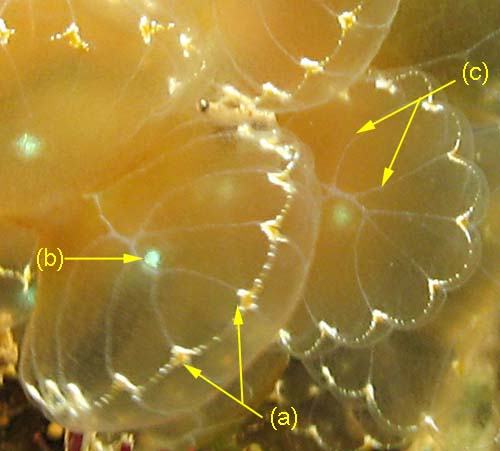This species has been observed on Mayotte and Madagascar Islands
This species is translucent cream, faint orange to dusky brown. The broad, oval, pillow-like cerata are edged with cream, gold or white flecks and often show an iridescent internal blue to green spot under some lighting conditions. When examined closely, the cerata are divided into sections by a network of transparent vein-like lines. |

|
|
| Showing species characteristics... | Photo Philibert Bidgrain |
|
Remarks :
Bibliographic data :
|
 |
References :
Bill Rudman Seaslug site : Sea Slug Forum : Cyerce elegans
Nudipixel Cyerce elegans
Publications :
Bergh, L.S.R. (1870). Malacologische Untersuchungen. In: C.G. Semper, Reisen im Archipel der Philippinen, Wissenschaftliche Resultate. Band 2, Heft 1 : 1-30, Pls. 1-8
Jensen, K.R. (2007). Biogeography of the Sacoglossa (Mollusca, Opisthobranchia). Bonner Zoologische Beiträge. 55: 255–281
Other photos of Cyerce elegans :
Philibert Bidgrain Mayotte, Mtsanga Guini, less 1 m, 12 October 2008, size : 60 mm
One distinctive feature, more easily visible in darker animals, is the irisdescent blue spot of each cerata Depending upon diet and locality, specimens of this species vary from nearly transparent white to reddish-brown. |
 |
 |
Eva Fontaine Mayotte, Mtsanga Guini, less 1 m, 31 July 2010, size 35-40 mm The broad, oval, pillow-like cerata are edged with cream, gold or white flecks (a) and often show an iridescent internal blue to green spot (b) under some lighting conditions. When examined closely, the cerata are divided into sections by a network of transparent vein-like lines (c) 
|
Philibert Bidgrain Mayotte, Mtsanga Mtiti Sada, less 1 m, 20 July 2010, size 25-30 mm |
|
 |
Like other Cyerce this species have : the sole of the foot bears a transversal groove (a) across its center  |
 |
Alain-Benoît Rassat Madagascar, Nosy Bé, size : 25 mm |
More photos from Indian Ocean
Mayotte, bifurcated rhinophores of Cyerce elegans, by Fabrice Schubert
Mayotte, inflated cerata of Cyerce elegans, at Sakouli, by Matthias Deuss